SilverStone Heligon HE01 vs. Phanteks PH-TC14PE Review

Today we will witness an exciting battle for the ultimate winner’s crown between our long-term favorite and a new CPU cooler from SilverStone.
If we draw some parallels between the CPU air coolers and professional boxing, then products like Noctua NH-D14, Phanteks PH-TC14PE or Thermalright Silver Arrow SB-E would definitely be classified as super heavy-weights. Real fighters enter the ring not so often, about once every 7-9 months, and only a few ones will become ultimate champions. Today SilverStone Technology Co., Ltd. will send in their challenger – SilverStone Heligon HE01 cooler.
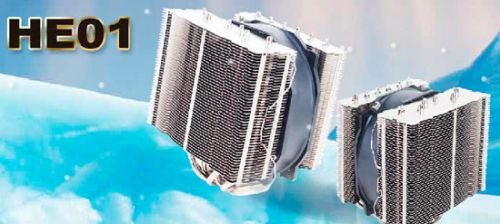
Packaging and Accessories
The new SilverStone cooler comes in a medium sized box with a modest design:
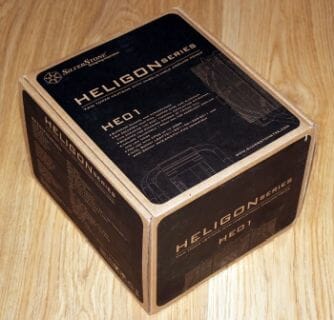
However, despite the simplistic design, the package is exceptionally informative. Inside the external box made of thick cardboard we find soft polyurethane foam casing with the cooler:
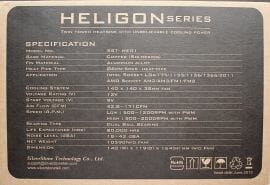
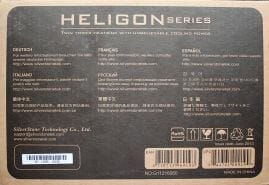
All accessories and manuals are arranged in a separate box at the bottom of the package.
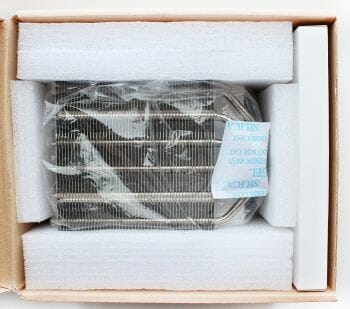
Among them are: a universal backplate, retention kits for different platforms, bushes, screws and mounts, thermal paste, wire clips for the fans and an installation manual:
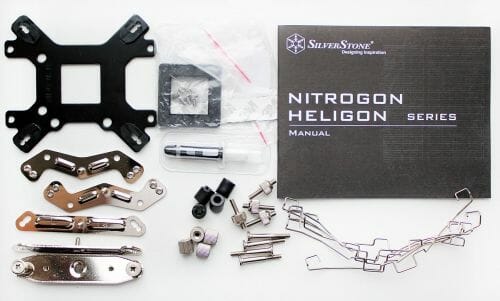
The cooler is made in China. It is priced at $74.99 and comes with a 1-year warranty.
Design and Functionality
On the outside, the new SilverStone Heligon HE01 doesn’t seem that new and looks very similar to Noctua NH-D14 and a number of other two-tower coolers. The key feature that distinguishes it from all other products is the asymmetrical heatsink arrays:
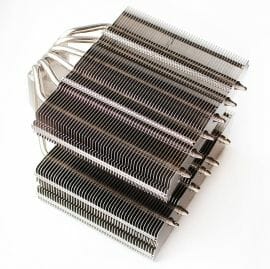
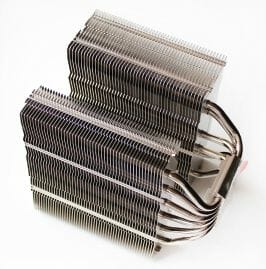
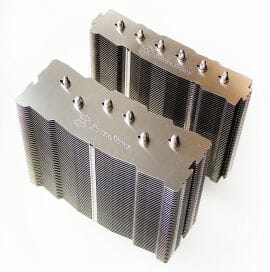
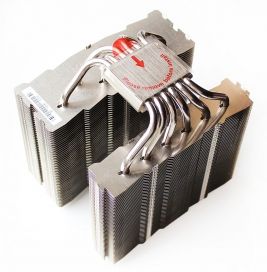
At the same time, the cooler is pretty large: the heatsink measures 160x140x119 mm and weighs 915 grams.
The two-array heatsink is built around six copper heatpipes 6 mm in diameter. The heatpipes pierce the copper base and both heatsink arrays, each made of 47 aluminum fins 0.4 mm thick. The gaps between the fins are 1.9-2.0 mm:
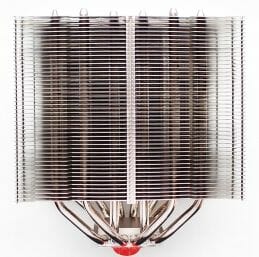
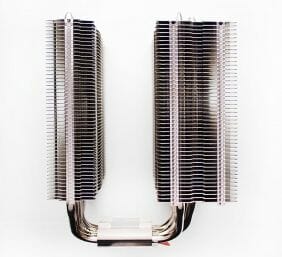
The smaller heatsink array is 30 mm wide. The heatpipes go through it in a single straight line. The larger heatsink array is 50 mm wide and it bears the primary thermal load. The heatpipes inside this array are shifted away from one another:
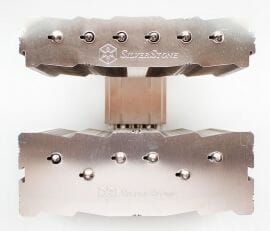
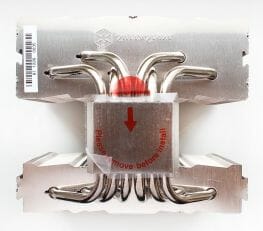
The calculated effective cooling surface of this heatsink is about 10,940 cm2, which is very close to what the best air coolers out there have. The entire heatsink is nickel-plated. It would be logical to assume that the smaller heatsink array is at the airflow entry, and then fan will be pushing the airflow through the larger heatsink array.
The heatpipes lie inside special grooves in the cooler base and are soldered to it. The thinnest part of the base beneath the heatpipes measures only 2 mm. As for the contact method between the fins and the heatpipes, they are most likely pressed against the heatpipes, because we didn’t notice any traces of glue or soldering anywhere:
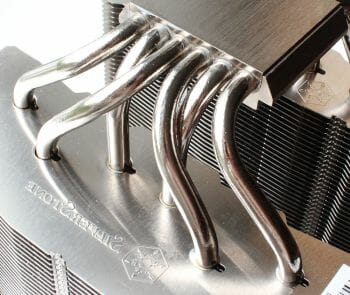
The base contact surface is a rectangle 42×38 mm big. It doesn’t look that perfect, but you can’t feel any machine marks to the touch:
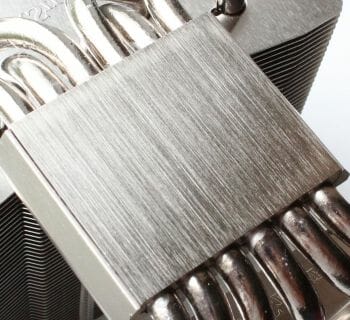
We didn’t detect any serious curving during our standard metal ruler check, but some unevenness is indeed present:
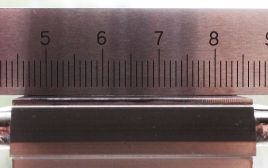
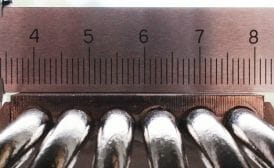
As for the thermal paste imprint, it turned out almost flawless:
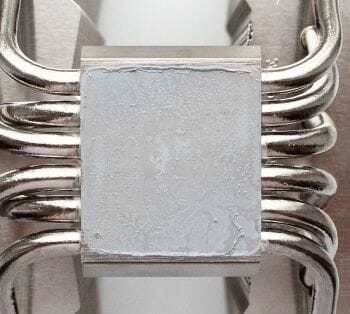
Strange as t might seem, but the most interesting part of the SilverStone Heligon HE01 cooler is, in our opinion, its SST-FHP141-H fan. This is a large 140 mm seven-blade fan 38 mm thick! It does look pretty brutal:
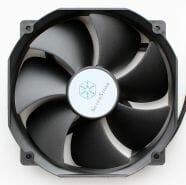
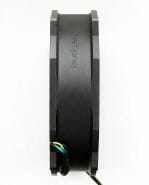
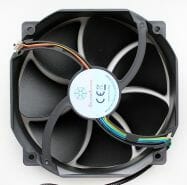
The massive pretty large blades are aggressively curved like the wind-blown sails of the Black Pearl ship. Three robust 7 mm rays and one 9 mm ray with a stator hold the impeller in place. The impeller diameter is 131 mm, and the stator diameter is 44 mm.
This super-fan rotation speed can be adjusted automatically using PWM method in two speed ranges. You can switch between the two speed intervals by flipping a small switch right on the fan itself:
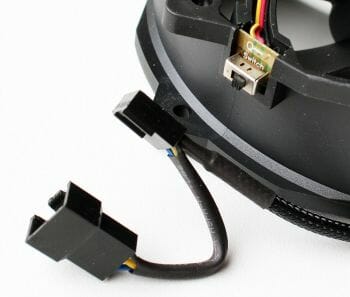
The first rotation speed range could be considered acoustically comfortable, because its minimal setting is close to 500 RPM, and the maximum speed is at 1200 RPM. In the second case the fan will be rotating at 500-2000 RPM. Can you imagine a 38 mm thick 140-mm fan spinning at 2000 RPM? This is a killer! And the technical specifications confirm this: 171 CFM airflow and 41 dBA noise. The static pressure is not mentioned, but with the parameters like that, this fan will push through any heatsinks, even the densest ones.
The fan is built with a dual ball bearing with a guaranteed MTBF of 80,000 hours or over 9 years. The fan’s electrical parameters are mentioned on the rotor sticker:
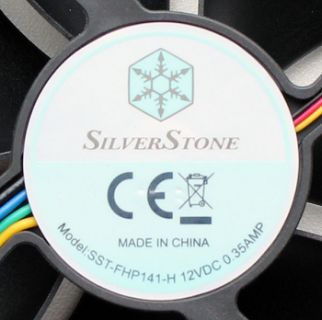
By the way, the maximum power consumption of this fan turned out pretty modest for its size and rotation speed and equals only 4.2 W. the startup voltage is declared at 9 V, but our tests indicated that the fan could take off easily at 5 V. the fan power cable is pretty short: only 255 mm.
To reduce the vibrations transferred from the fan frame to the heatsink fins, you should use provided silicone pads, which should be stuck to the fastening loops:
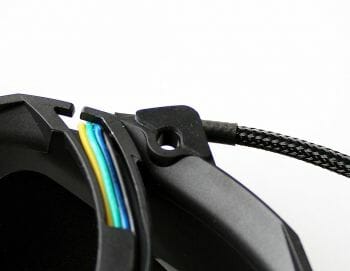
The fan is then installed between the heatsink arrays and is attached to one of them with the provided wire clips:
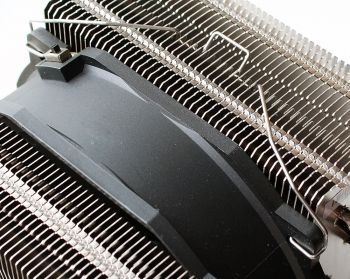
The cooler comes with three sets of clips like that and four shock-absorbing silicone pads, so theoretically you can arm SilverStone Heligon HE01 with another two fans. It is a pity, however, that the powerful 140 mm SilverStone SST-FHP141-H fan cannot be purchased separately yet.
This is what the SilverStone Heligon HE01 looks like with the fan installed:
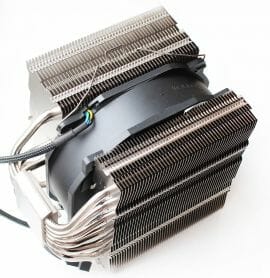
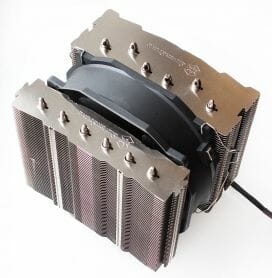
Compatibility and Installation
Like any other cooler from the upper price segment, SilverStone Heligon HE01 is compatible with all contemporary platforms. It can be installed onto Intel LGA 775/1155/1156/1366/2011 processors or AMD Socket AM2(+)/AM3(+)/FM1/FM2 processors. The installation procedure described in detail in the official manual. We are going to discuss it step by step with the help of our LGA 2011 test platform.
The first thing you do is insert threaded mounting spindles into the socket retention holes. After that a pair of steel rails is attached to them with thumb-screws:
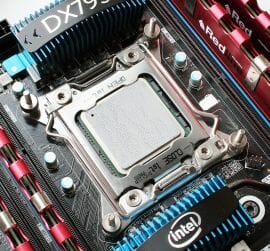
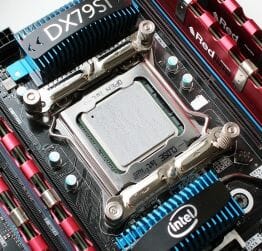
Next you place the heatsink on top and evenly tighten the spring-screws over the retention plate holding the cooler in place:
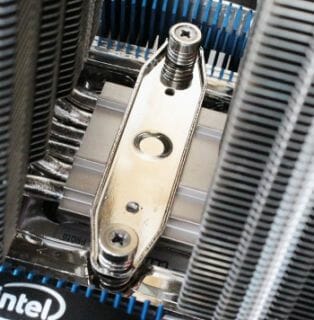
The last step is to insert the cooling fan between the heatsink arrays and make sure the wire clips catch on securely to the heatsink sides. Once installed, the fan will be hanging 15 mm below the last heatsink fin, but since it is sitting between the heatsink arrays and has a round frame, it won’t interfere with the heatsinks over the mainboard voltage regulator components:
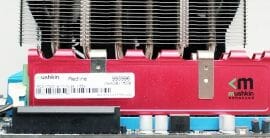
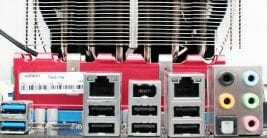
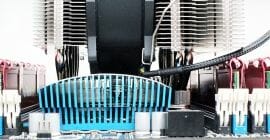
The clearance between the mainboard and the lowest heatsink fin is more than 45 mm, therefore there is enough room even for memory modules with not very tall heat-spreaders.
The new SilverStone Heligon HE01 doesn’t look as bulky inside the assembled system case, as it does when we take it out:
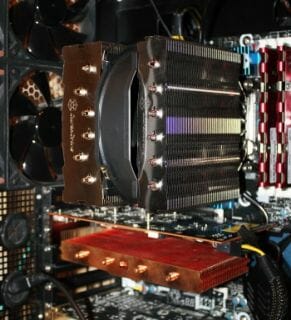
Technical Specifications and Recommended Pricing
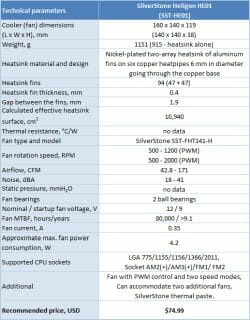
Testbed Configuration and Testing Methodology
We tested all coolers inside a closed system case with the following configuration:
- Mainboard: Intel Siler DX79SI (Intel X79 Express, LGA 2011, BIOS 0537 from 07/23/2012);
- CPU: Intel Core i7-3960X Extreme Edition, 3.3 GHz, 1.2 V, 6 x 256 KB L2, 15 MB L3 (Sandy Bridge-E, C1, 32 nm);
- Thermal interface: ARCTIC MX-4;
- Graphics card: Asus Radeon HD 6770 DirectCU Silent (EAH6770 DCSL/2DI/1GD5) GDDR5 128 bit, 850/4000 MHz (with a passive heatsink from the DeepCool V4000 VGA cooler);
- System memory: DDR3 4 x 4GB Mushkin Redline (Spec: 2133 MHz / 9-11-10-28 / 1.65 V);
- System drive: Crucial m4 256 GB SSD (SATA-III,CT256M4SSD2, BIOS v0009);
- Drive for programs and games: Western Digital VelociRaptor (300GB, SATA-II, 10000 RPM, 16MB cache, NCQ) inside Scythe Quiet Drive 3.5” HDD silencer and cooler;
- Backup drive: Samsung Ecogreen F4 HD204UI (SATA-II, 2 TB, 5400 RPM, 32 MB, NCQ);
- System case: Antec Twelve Hundred (front panel: three Noiseblocker NB-Multiframe S-Series MF12-S2 fans at 1020 RPM; back panel: two Noiseblocker NB-BlackSilent PRO PL-1 fans at 1020 RPM; top panel: standard 200 mm fan at 400 RPM);
- Control and monitoring panel: Zalman ZM-MFC3;
- Power supply: Seasonic SS-1000XP Active PFC F3 1000 W (with a default 120 mm fan).
For the primary tests and summary diagrams we overclocked our six-core processor with the clock generator frequency set at 125 MHz, the multiplier at 35x and “Load-Line Calibration” enabled to 4.375 GHz. The nominal processor Vcore was increased to 1.385 V in the mainboard BIOS. After that we tested the new coolers at even higher frequency and voltage settings. Turbo Boost was disabled during this test session, and Hyper-Threading technology was enabled to increase the heat dissipation. The memory voltage was at 1.65 V and its frequency was 2000 MHz with 9-10-10-28 timings. All other parameters available in the mainboard BIOS and related to CPU or memory overclocking remained unchanged.
All tests were performed under Windows 7 Ultimate x64 SP1 operating system. We used the following software during our test session:
- LinX AVX Edition version 0.6.4 – to load the processor (memory – 4500 MB, Problem Size – 24234, two 11-minute cycles);
- Real Temp GT version 3.70 – to monitor the processor core temperatures;
- Intel Extreme Tuning Utility version 3.1.201.5 – for monitoring and visual control of all system parameters during overclocking.
So, the complete screenshot during the test session looks as follows:
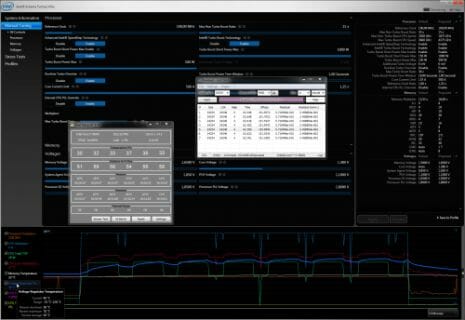
The CPU was loaded with two consecutive LinX AVX test runs with the settings as indicated above. The stabilization period for the CPU temperature between the two test cycles was about 8-10 minutes. We took the maximum temperature of the hottest CPU core for the results charts. Moreover, we will also provide a table with the temperature readings for all cores including their average values. The ambient temperature was checked next to the system case with an electronic thermometer with 0.1 °C precision that allows hourly monitoring of the temperature changes over the past 6 hours. The room temperature during our test session varied between 21.8-22.2°C.
The noise level of each cooler was measured between 1:00 and 3:00 AM in a closed room about 20 m2 big using CENTER-321 electronic noise meter. The noise level for each cooler was tested outside the system case when the only noise sources in the lab were the cooler and its fan. The noise meter was installed on a tripod and was always at a 150 mm distance from the cooler fan rotor. The tested cooling systems were placed at the edge of the desk on a sheet of polyurethane foam. The lowest noise reading our noise meter device can register is 29.8 dBA and the subjectively comfortable noise level in these testing conditions was around 36 dBA (do not mix it up with low noise level). The fan(s) rotation speed was adjusted in the entire supported range using our in-house controller by changing the voltage with 0.5 V increment.
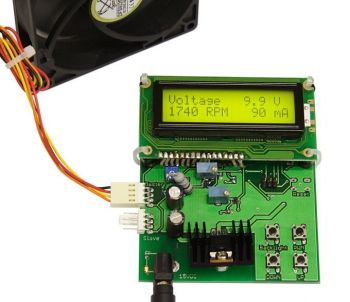
As you may have already understood from the introductory part of this review, SilverStone Heligon HE01 will be competing against the super-heavyweight – Phanteks PH-TC14PE cooler equipped with two default PH-F140TS fans:
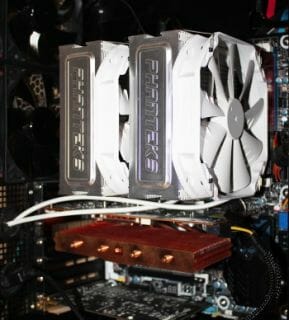
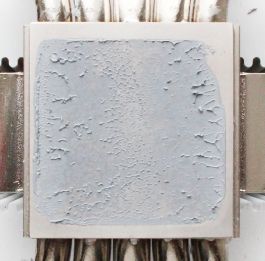
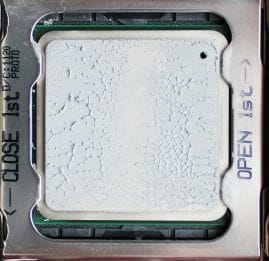
We also tested SilverStone Heligon HE01 with the same exact fans:
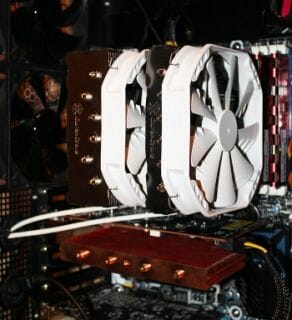
I would also like to add that the rotation speed of all fans was controlled using the same special controller I mentioned above with ±10 RPM precision.
Performance
Cooling Efficiency
The results of our cooling efficiency tests are given on the following diagram and in the following table:
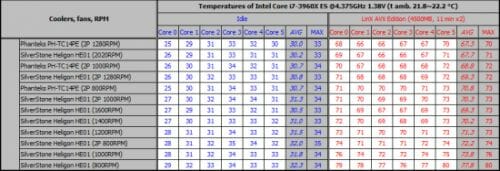
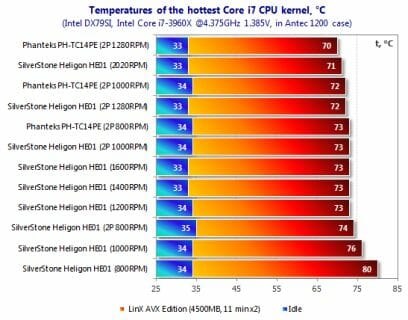
This was a really intense battle. SilverStone Heligon HE01 did a great job withstanding the force of Phanteks PH-TC14PE and yielded only 1°C at the maximum fan speed and 1-2°C when tested with alternative Phanteks fans. The big and thick 140 mm SilverStone fan helped Heligon HE01 maintain such superb cooling efficiency that in 1200-1600 RPM range the temperatures of the hottest processor core are identical. Only at 1000 RPM the temperature increases by 3°C, and when the rotation speed drops to 800 RPM – by another 4°C. Note that Heligon HE01 heatsink responded very well to the use of two Phanteks fans. For example, the cooling efficiency of the Heligon HE01 at 1000 RPM of the Phanteks fans was identical to its cooling efficiency at 1600 RPM of the default fan. And at the maximum 1280 RPM speed of the Phanteks fans SilverStone cooler demonstrated only 1°C lower result than with the default 140×38 mm fan at its maximum speed.
Obviously we can’t unveil the coolers potential fully at 4.375 GHz CPU clock frequency and 1.385 V Vcore, that is why we overclocked our test CPU even more – to 4.5 GHz at 1.42 V Vcore. Although SilverStone Heligon HE01 didn’t cope with this aggressive overclocking at 800 RPM speed of the default fan as well as two Phanteks fans. Therefore, you won’t find these results on the diagram:
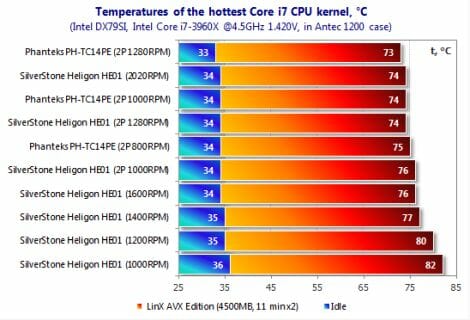
And again the race is really neck and neck. Even though the flagship Phanteks PH-TC14PE cooler kept its leadership in this competition, the results of SilverStone Heligon HE01 deserve our absolute respect. This is a truly outstanding product!
You can compare the results of our today’s testing participants against the previously tested products in the following table and diagram*. Each cooler was tested in its default configuration in the quiet mode and at the maximum speed of the fan(s) with the CPU overclocked to 4.375 MHz at 1.385 V Vcore.
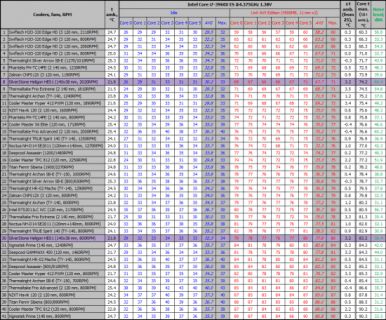
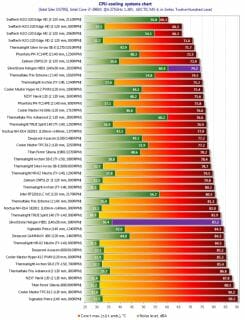
As we can see, at the maximum fan speed SilverStone Heligon HE01 ranks among the best air coolers falling as little as 2°C behind only three other products. The results obtained in quiet mode at 800 RPM are also very impressive, because it outperformed over a dozen very popular coolers. However, being so close to the 40-dollar Thermalright TRUE Spirit 140 makes the investment in SilverStone Heligon HE01 for use in quiet mode quite questionable.
As for the summary diagram with the maximum CPU overclocking results, here SilverStone Heligon HE01 ranks as one of the super-heavyweights, even though it failed to conquer the maximum frequency of our test processor (4.625 GHz at 1.46 V):
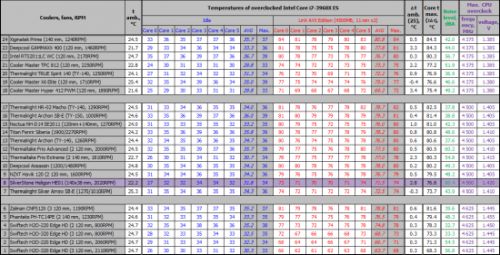
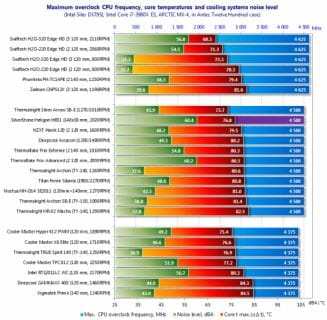
Acoustic Performance
We measured the noise level of our coolers throughout the entire speed range of their fans, as described in the chapter on testing methodology. Here are the results:
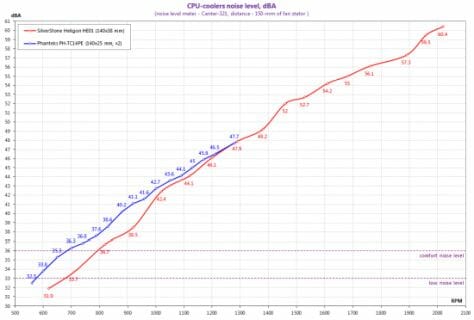
When we assess the level of noise generated by SilverStone Heligon HE01 compared against its today’s rival, we should remember that Phanteks PH-TC14PE is not really a quiet cooler therefore the nominal victory of the new SilverStone product at the same fan rotation speeds doesn’t proclaim it an undefeated winner. It is true, Heligon HE01 is quieter than PH-TC14PE up to 1200 RPM, but is it really quiet? Unfortunately, not. Only up to 650-700 RPM the 140 mm SilverStone Heligon HE01 fan is really quiet, and it remains within the zone of subjective acoustic comfort up to 800 RPM. By the way, SilverStone set the minimum rotation speed for both PWM modes at 500 RPM for a reason: at this speed you won’t hear a thing even if you have the quietest system out there. However, when the CPU utilization is high, when the fans rotate faster than 800-900-1000 RPM, the noise from SilverStone Heligon HE01 starts becoming more distinct, and at even higher speeds it becomes distracting. No everyone will be able to put up with the noise at the maximum fan speed. I have to add that we didn’t detect any vibrations, beating, crackling or any electric sounds during the fan operation. This is a really high-quality product, which currently cannot be purchases separately. Otherwise, it could become a real hit among those overclockers who do not mind the noise.
Conclusion
Our today’s super-heavyweight fight has definitely been a success. It was exciting and unpredictable, and in some cases it was really hard to determine who the winner was. Although the overall results and the maximum conquered processor frequency didn’t let the new SilverStone Heligon HE01 take the best super-cooler title, it did perform great and demonstrated impeccably high level of cooling efficiency, which is currently only attainable for as few as 3-4 other products from the best cooler makers. Moreover, SilverStone cooler boasts more attractive 75-dollar price tag, while the same Phanteks PH-TC14PE and Thermalright Silver Arrow SB-E start at $90. Absolutely universal and reliable retention, simple installation, compatibility with tall heatsinks on the VRM components and tall memory heat-spreaders, strict and stylish exterior – what else could you wish for? I think this model has it all. Although some restless overclockers would probably rave about something like “Heligon HE01 Extreme” with two large symmetrical heatsink arrays and a couple of SST-FHP141-H fans… I am sure that a super-cooler modification like that would undoubtedly take over the lead in the CPU coolers segment. And maybe SilverStone will try to make our dreams come true one day? Well, all we can do is wait and see.